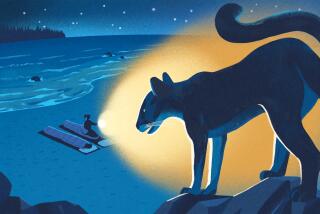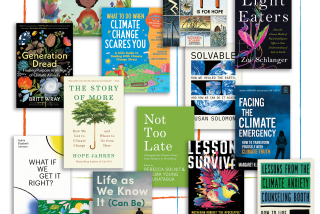Review: ‘Wildhood’ explores how teens have a surprising amount in common with adolescent animals
- Share via
Barbara Natterson-Horowitz, a physician who codirects UCLA’s Evolutionary Medicine Program, and Kathryn Bowers, a science journalist, stood on a sand dune near Monterey several years ago and contemplated the so-called triangle of death. Great white sharks fill the waters here, easily stalking prey due to the absence of kelp forests that provide cover.
Nevertheless, adolescent California sea otters daringly venture into the perilous waters to frolic. Some pay with quick, violent deaths. But most survive and return with the skills and confidence they’ll need to navigate adulthood and raise their own young.
Whether you’re a parent of a teenager or just someone with memories of your own life between ages 13 and 19, it’s easy to see the parallel between young otters’ risky swimming and young humans venturing onto freeways or exposing themselves to myriad dangers as they learn the ways of the world.
That’s precisely the connection Natterson-Horowitz and Bowers (authors of the 2012 bestseller “Zoobiquity,” about parallels between human and animal health) want readers to make in their new book, “Wildhood.” The authors introduce the idea that the not-quite grown-up creatures of various species — including ours — share a horizontal connection, “a temporary membership in a planet-wide tribe of adolescents.” They say much of what human and animal teens experience is routed in the evolutionary past.
To make that case, Natterson-Horowitz and Bowers — both of whom have raised teenage offspring — have amassed a mountain of findings from scientific literature, interviews with animal researchers and field observations of their own.
Readers of “Wildhood” will learn, for example, that adolescent Thomson gazelles use a showy, bouncing gait to convince cheetahs that they are too difficult to pursue and kill — just like a 15-year-old boy who strides down the hallway with his chest thrust out to deter bullies. The book explains that young mammals, birds and even insects experience a phenomenon scientists call Zugunruhe — a German term meaning “migration anxiety” — when they venture out into the world, and they experience hormonally driven sleep disturbances akin to those of high-school students.
We also discover that hyena clans practice a form of communal daycare and that adolescents achieve popularity through a behavior called “social coalition walking.” That’s the equivalent of a human teen inviting a friend to go to Starbucks or shoot hoops at the playground. Groups of young humpback whales, like high-schoolers at the mall, can be boisterously rowdy as they practice courtship rituals, and females humpback whales are drawn to love songs. Adolescents of myriad species tend to have ravenous appetites, an urge that seems to be an evolutionary preparation for dispersing from the family nest.
To impose order upon this panoply of facts and give “Wildhood” a narrative structure, the authors zoom in on the coming-of-age sagas of several adolescent animals in the wild, all tracked by scientists. We’re introduced to Ursula, a king penguin born and raised on South Georgia Island off Antarctica. The penguin must leave its home turf and venture into unfamiliar waters to face the peril of leopard seals that have jaws big enough to swallow a basketball. Shrink, a spotted hyena in Tanzania that’s the offspring of a low-status female, fights bullies and makes friends to survive what the authors call “the hierarchical hyena version of high school.” Salt, a female North Atlantic humpback whale born near the Dominican Republic and spending summers in the Gulf of Maine, experiences sexual desire and learns to communicate wants and needs to males.
The adolescent animals’ stories, while fascinating, might leave some readers a little frustrated because of the limited amount of data scientists were able to gather in the wild. In the case of Ursula, for example, the transmitter scientists used to track the penguin went dead after three months, so the rest of Ursula’s life is a mystery. Another creature, a young mountain lion, dies after inadvertently venturing into human civilization.
The most compelling, detailed story is that of Slavc, a wolf that leaves northeastern Italy on a solo journey and ventures through mountains, contending with hunger and isolation. It’s a tale that’s both sad and uplifting, a tribute to the resilience that adolescents possess.
The vivid storytelling and fascinating scientific digressions in “Wildhood” make it a pleasurable read. It’s also a book parents may find reassuring: The authors show that the often painful struggles human and animal adolescents go through are a way of developing the skills and experience that will make it possible for them to function as adults. The book describes how animals engage in “parental meanness” to push their young to strike out on their own. Mountain lion mothers will go so far as to lead their cubs to the edge of their territory and walk away, discouraging adolescents from following with a snarl or a smack of the paw. Anyone who’s been trying to cajole a recent college graduate into moving out of the house can relate.
But there’s also another implicit message in “Wildhood” about the interconnection among the planet’s species. The authors note that all have managed to survive over countless generations and millions of years by evolving to deal with common pressures and challenges. The awareness that we’re all in this together ought to motivate humans to stop ravaging the planet so it can continue to be a place where adolescents of many different species can find their ways into adulthood.
Wildhood: The Epic Journey From Adolescence to Adulthood in Humans and Other Animals
Barbara Natterson-Horowitz and Kathryn Bowers
Scribner: 368 pages; $27
Kiger has written for GQ, Sierra magazine, Fast Company and History.com. He’s also cowritten two nonfiction books, “Poplorica” and “Oops.”
More to Read
Sign up for our Book Club newsletter
Get the latest news, events and more from the Los Angeles Times Book Club, and help us get L.A. reading and talking.
You may occasionally receive promotional content from the Los Angeles Times.








